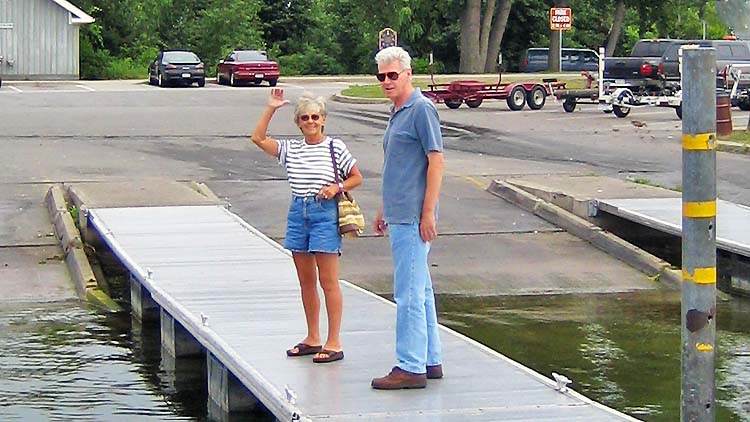Riparian Rights


Riparian rights are the legal rights of owners of land bordering on a river or other body of water. Those rights include the right to the water in its natural state; the right of access to the water; and the right to accretions (gains through soil deposits) on the land.
Riparian refers to the rights of those owning land along a river to have access to the waterway.
In the 1973 case of Board of Trustees v. Medeira Beach Nominee, Inc. (272 So. 2d 209) decided by the Florida Appellate Court, the disagreement between the parties appeared to be whether the "established rule of law should be followed or whether there should be recognized or created an exception to the general rule." The court ruled in favor of Medeira Beach Nominee, Inc., the private land owner, and against the State of Florida.

But what exactly is the established rule of law? And when did riparian rights and public trust laws first come into being? Not surprisingly, the definitions date back to the legal interpretations developed under the sponsorship of the Byzantine emperor Justinian I (AD 529 to 5650). Under Roman law, the air, the rivers, and the sea were incapable of private ownership. They were dedicated to the use of the public. The concept that submerged lands are unique and that the state holds them in trust for the people has endured throughout the ages. In 13th century Spain, for example, public rights in navigable waterways were recognized in Las Siete Partidas, the laws of Spain set forth by Alfonso the Wise.
Under English common law, this principle evolved into the public trust doctrine pursuant to which the sovereign held the navigable waterways and submerged lands, not in a proprietary capacity, but rather “as trustee of a public trust for the benefit of the people” for uses such as commerce, navigation and fishing. Note the key words navigable waterways and submerged lands. The public trust doctrine has no bearing on land above the water line - on who owns the beach. Note also that while Codex Justinianus may have assisted in the evolution of our current laws, it's unlikely to decide the outcome of a case today. English Common Law, however, is still relevant in New York State.

Jefferis v. East Omaha Land Co.
The grounds upon which the circuit court proceeded in overruling the demurrer to the bill are stated by it in its opinion to be these:
(1) It being alleged in the bill that the added land was formed by 'imperceptible degrees,' although the increase was great, resulting in the addition of many acres, yet the time during which it was made was nearly 20 years, and an increase might have been going on, imperceptible from day to day and from week to week, which, during the lapse of so many years, might result in the addition of all the land; and hence the averment of the bill cannot be overthrown, notwithstanding what is known of the character of the Missouri river, and of the soil through which it flows, and of the rapid changes in its banks which are constantly going on.
(2) Where a water line is the boundary of a given lot, that line, no matter how it shifts, remains the boundary, and a deed describing the lot by number or name conveys the land up to such shifting water-line, exactly as it does up to the fixed side lines; so that, as long as the doctrine of accretion applies, the water-line, no matter how much it may shift, if named as the boundary, continues to be the boundary, and a deed of the lot carries all the land up to the water-line.
The bill must be held to state a fact, in stating that the land in question was formed by 'imperceptible degrees,' and that the process, begun in 1853 and continued until 1870, resulting in the production by accretion of the tract of 40 acres and more, 'went on so slowly that it could not be observed in its progress, but at intervals of not less than three or more months it could be discerned by the eye that additions greater or less had been made to the shore.'
The fact, as thus stated, is that the land was formed by imperceptible degrees, within the meaning of the rule of law on the subject, and it is not capable of any construction which would result in the conclusion that the land was not formed by imperceptible degrees. In the Roman law it was said, in the Institutes of Gaius, (book 2, § 70:) 'Alluvion is an addition of soil to land by a river, so gradual that in short periods the change is imperceptible; or, to use a common expression, a latent addition.' Justinian says, (Inst. bk. 2, tit. 1, § 20:) 'That is added by alluvion which is added so gradually that no one can perceive how much is added at any one moment of time.'
The same rule was introduced into English jurisprudence. Bracton says, (book 2, c. 2:) 'Alluvion is a latent increase, and that is said to be added by alluvion, whatever is so added by degrees, that it cannot be perceived at what moment of time it is added; for, although you fix your eye-sight upon it for a whole day, the infirmity of sight cannot appreciate such subtle increments, as may be seen in the case of a gourd, and such like.'
Blackstone says, (2 Comm. 262:) 'And as to lands gained from the sea, either by alluvion, by the washing up of sand and earth, so as in time to make terra firma; or by dereliction, as when the sea shrinks back below the usual water-mark, in these cases the law is held to be that if this gain be by little and little, by small and imperceptible degrees, it shall go to the owner of the land adjoining, for de minimis non curat lex; and, besides, these owners being often losers by the breaking in of the sea, or at charges to keep it out, this possible gain is, therefore, a reciprocal consideration for such possible charge or loss.'
The whole subject was fully considered in England in the case of Rex v. Lord Yarborough, 3 Barn. & C. 91, in the King's Bench, same case, in the house of lords, 2 Bligh, (N. S.) 147, and 1 Dow & C. 178; same case, sub. nom. Gifford v. Lord Yarborough, 5 Bing. 163, in the house of lords.
Ransom v. Shaeffer
This action is one to enforce the specific performance of a contract by which the plaintiff agreed to sell and the defendant to purchase certain beach property located on Lake Ontario at Olcott, N.Y.
One of the defenses interposed is that Washington H. Ransom never had a good title to the lots sold, because the legal title to the land extended only to the high-water mark of Lake Ontario. The evidence is that the level of the water of the lake varies and there has been a difference in the past of from four to five feet between extreme high and extreme low water; and that when the lake level has been at its highest, much of the beach is covered by the waters of the lake, and on the theory that Ransom's title ran only to the high-water line a great part of the lots shown on the map referred to was so covered and his title so failed.
Now the contract between the parties describes what is sold and to be conveyed simply as "all of the interest of the late Washington H. Ransom in the lands and premises north of Beach Street of said map and lying between the Government Pier on the east and Jackson Street on the west." Distances and quantity were evidently purposely omitted owing to the well-known fact that the width of the beach varied by the changing height of Lake Ontario, and possibly too because there was some question as to whether the legal title to the land stopped at high-water mark of Lake Ontario.
The referee thinks it quite plain it was only the intention of the plaintiff to sell and of the defendant to buy such interest as the late Washington H. Ransom had in the beach property and no more whether his title ran to high- or low-water line. The defendant was bound to take and pay for such interest no matter where the line of high-water mark ran. There could be no deception practiced for the defendant is and has been for years a resident of Olcott and perfectly familiar with the property in question. We, therefore, are of the opinion the defense of want of title not well taken.
It is, however, an interesting question whether Ransom's title is bounded by the high-water line or runs to the waters of the lake, whether high or low. The view above expressed is fortified by the clause in the contract declaring: "First party shall not be held responsible for any encroachments of high water or the results thereof."
As to whether or not Ransom had title in fee to the land between high-water mark and low-water mark of Lake Ontario may be the subject of much discussion.
It is well established by the decisions of the courts of this State that grants of land bounded by waters where the tide rises and falls only carries the legal title to high-water mark. ( Wheeler v. Spinola, 54 N.Y. 377 ; People ex rel. Burnham v. Jones, 112 id. 597.) However, Lake Ontario is not a body of water where the tide rises and falls. The difference in the level of the waters of the lake is caused by the seasonal weather, by heavy rains prevailing over the sections of the country drained by the Great Lakes, or by prolonged droughts affecting streams finding the lakes. Consequently the heights of levels in the Great Lakes varies greatly from the uniform level of the ocean only affected by the rise and fall of tides.
For these reasons the courts of this State have drawn a distinction in the rule of law to be applied to lands on tidal waters, and land on inland lakes where no tide rises or falls.
The comparatively recent case of Stewart v. Turney ( 237 N.Y. 117 ) related to the title of certain lands on the east shore of Cayuga lake, a body of water some thirty-six miles long by one to three wide. The grant in question was of "Farm Lot 86, Late Cayuga Reservation which lies on the east side of Cayuga lake." The map of the reservation referred to shows this lot abutting on the lake.
Stretching eastward from the water was a beach of gravel and boulders some thirty feet in width. The gravel beach was for much of the year free from water, but when the lake is high the beach is overflowed so that in extreme high water small boats can pass over it. The action was for trespass by the defendant entering on the beach, and the question to be decided was whether the plaintiff had title to the beach, which depended on the meaning and effect of the grant from the State. After discussing various decisions, the court held that under the grant by the State, the grantee took to low-water mark, and the plaintiff acquired whatever title was acquired by the original grantee.
Practically the same conditions obtain on the shores of Lake Ontario as on Cayuga lake, and the referee is unable to see why the same rule of law should not apply to grants of land on the shores of Lake Ontario as apply to lakes like Cayuga. The only difference is in the size of the two lakes, but that one principle cannot be controlling. We, therefore, hold the title of Ransom ran to low-water mark on the shores of Lake Ontario.
Public Trust, Riparian Rights, and Aquaculture
This article reviews the common law on riparian rights and public trust rights. It traces these doctrines from their English roots to their arrival at our shores during colonial times. The writer notes that "The shoreline and submerged flats are the crucible where rights of common law origin join in amalgamation of legal doctrine."
"It is axiomatic that under the common law the ownership of the tidelands and submerged flats was with the Crown. However, the power to use and alienate such lands was determined in part by the interplay of public and private interests, the jus publicum and jus privatum. The source of the right of navigation pre-dates the Magna Carta where it was made one of the comer stones of English law."
"In the United States, the state legislatures hold both jus publicum and jus privatum. Thus, interference with the right of navigation by obstructing or limiting a channel may only be done with legislative leave."
"Under common law, a riparian owner's rights include inter alia: the right to the water in its natural state (or close to it); the right of access to the water; the right to accretions on the land; the right to use the shore to draw nets; the right to wharf-out (subject to some restrictions for navigation); and the right to use the water adjacent to the property to conduct business."
Recommended Reading
"When the line between water and land is changed by the gradual deposit of soil, or by gradual recession of water, the owner becomes entitled to the new land. Conversely, if land bordering on water is gradually washed away, or the water gradually encroaches, the owner loses such land unless he retains its ownership as having title to the land under the water."
River and Lake Boundaries - a Manual, by James A. Simpson"The legal effect of accretion is that the upland owner gets to keep the additions attached to his land. The ordinary high water mark is the limit of the ownership in many states. The low water mark is used in some other states (New York being one of them) while a few states use a hybrid system."
Recreational Access and Owner Liability, by Tommy L. Brown"The beds of Lakes Ontario and Erie, some other large lakes in New York, and major rivers (the Hudson and the Mohawk) are publicly owned. Thus, recreationists have the right to use these waters. However, they do not have the right to cross private lands to reach these waters without obtaining permission from the riparian landowner. In addition, private ownership along these major waterways typically runs to the mean low water mark; and as a result, recreationists have no right, except in an emergency, to land on the shore where ownership is private."
Glossary
Riparian: Belonging to or referring to the shore of a river or stream. In common usage the term "riparian rights" often refers to the right to make use of and enjoy the benefits of any body of water.
Accretion: The gradual and imperceptible addition of soil to the shore of waterfront property. The test as to what is gradual and imperceptible is that though witnesses may see from time to time that progress has been made, they could not perceive it while the process was going on.
Ordinary High Water Mark: That line on the shore established by the fluctuations of water and indicated by physical characteristics such as a clear, natural line impressed on the bank, shelving, changes in the character of soil, destruction of terrestrial vegetation, the presence of litter and debris, or other appropriate means that consider the characteristics of the surrounding areas.
Low Water Mark: The level reached by seawater at low tide or by other stretches of water at their lowest level.
Public Trust Doctrine: A legal principle derived from English Common Law. The essence of the doctrine is that the waters of the state are a public resource owned by and available to all citizens equally for the purposes of navigation, conducting commerce, fishing, recreation and similar uses and that this trust is not invalidated by private ownership of the underlying land. However, the public does not have the right to cross private lands to reach these waters without obtaining permission from the riparian landowner. In addition, the public has no right, except in an emergency, to land on the shore where ownership is private.
